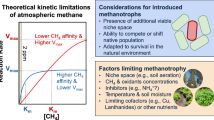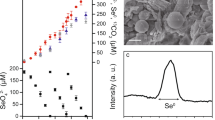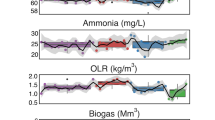Abstract
Although microorganisms coexist in the same environment, it is still unclear how their interaction regulates ecosystem functioning. Using a methanotroph as a model microorganism, we determined how methane oxidation responds to heterotroph diversity. Artificial communities comprising of a methanotroph and increasing heterotroph richness, while holding equal starting cell numbers were assembled. We considered methane oxidation rate as a functional response variable. Our results showed a significant increase of methane oxidation with increasing heterotroph richness, suggesting a complex interaction in the cocultures leading to a stimulation of methanotrophic activity. Therefore, not only is the methanotroph diversity directly correlated to methanotrophic activity for some methanotroph groups as shown before, but also the richness of heterotroph interacting partners is relevant to enhance methane oxidation too. In this unprecedented study, we provide direct evidence showing how heterotroph richness exerts a response in methanotroph–heterotroph interaction, resulting in increased methanotrophic activity. Our study has broad implications in how methanotroph and heterotroph interact to regulate methane oxidation, and is particularly relevant in methane-driven ecosystems.
Similar content being viewed by others
Log in or create a free account to read this content
Gain free access to this article, as well as selected content from this journal and more on nature.com
or
References
Agasild H, Zingel P, Tuvikene L, Tuvikene A, Timm H, Feldmann T et al. (2014). Biogenic methane contributes to the food web of a large, shallow lake. Freshwat Biol 59: 272–285.
Allison SD, Martiny JBH . (2008). Resistance, resilience, and redundancy in microbial communities. Proc Natl Acad Sci USA 105: 11512–11519.
Bell T, Newman JA, Silverman BW, Turner SL, Lilley AK . (2005). The contribution of species richness and composition to bacterial services. Nature 436: 1157–1160.
Bodelier PLE, Meima-Franke M, Hordijk CA, Steenbergh AK, Hefting MM, Bodrossy L et al. (2013). Microbial minorities modulate methane consumption through niche partitioning. ISME J 7: 2214–2228.
Cardinale BJ, Srivastava DS, Duffy JE, Wright JP, Downing AL, Sankaran M et al. (2006). Effects of biodiversity on the functioning of trophic groups and ecosystems. Nature 443: 989–992.
Goos P, Jones B . (2011) Optimal Design of Experiments: A Case Study Approach. Wiley: West Sussex, UK.
Hanson RS, Hanson TE . (1996). Methanotrophic bacteria. Microbiol Rev 60: 439–471.
Ho A, Lüke C, Frenzel P . (2011). Recovery of methanotrophs from disturbance: population dynamics, evenness and functioning. ISME J 5: 750–758.
Ho A, Frenzel P . (2012). Heat stress and methane-oxidizing bacteria: Effects on activity and population dynamics. Soil Biol Biochem 50: 22–25.
Ho A, Kerckhof F-M, Lüke C, Reim A, Krause S, Boon N et al. (2013). Conceptualizing functional traits and ecological characteristics of methane-oxidizing bacteria as life strategies. Environ Microbiol Rep 5: 335–345.
Horz H-P, Rich V, Avrahami S, Bohannan BJM . (2005). Methane-oxidizing bacteria in a Californian upland grassland soil: diversity and response to simulated global change. Appl Environ Microbiol 71: 2642–2652.
Hutchens E, Radajewski S, Dumont MG, McDonald I, Murrell C . (2004). Analysis of methanotrophic bacteria in Movile Cave by stable isotope probing. Environ Microbiol 6: 111–120.
Iguchi H, Yurimoto H, Sakai Y . (2011). Stimulation of methanotrophic growth in cocultures by cobalamin excreted by rhizobia. Appl Environ Microbiol 77: 8509–8515.
Kalyuzhnaya MG, Yang S, Rozova ON, Smalley NE, Clubb J, Lamb A et al. (2013). Highly efficient methane biocatalysis revealed in a methanotrophic bacterium. Nat Commun 4: 2785–2790.
Levine UY, Teal TK, Robertson GP, Schmidt TM . (2011). Agriculture’s impact on microbial diversity and associated fluxes of carbon dioxide and methane. ISME J 5: 1683–1691.
Liebner S, Zeyer J, Wagner D, Schubert C, Pfeiffer E-M, Knoblauch C . (2011). Methane oxidation associated with submerged brown mosses reduces methane emissions from Siberian polygonal tundra. J Ecol 99: 914–922.
Murase J, Frenzel P . (2008). Selective grazing of methanotrophs by protozoa in a rice field soil. FEMS Microbiol Ecol 65: 408–414.
Naeem S, Hahn DR, Schuurman G . (2000). Producer-decomposer co-dependency influences biodiversity effects. Nature 403: 762–764.
Naeem S, Li S . (1997). Consumer species richness and autotrophic biomass. Ecol 79: 2603–2615.
Philippot L, Spor A, Henault C, Bru D, Bizouard F, Jones CM et al. (2013). Loss in microbial diversity affects nitrogen cycling in soil. ISME J 7: 1609–1619.
Raghoebarsing AA, AJP Smolders, Schmid MC, Rijpstra IC, Wolters-Arts M, Derksen J et al. (2005). Methanotrophic symbionts provide carbon for photosynthesis in peat bogs. Nature 436: 1153–1156.
Stock M, Hoefman S, Kerckhof F-M, Boon N, de Vos P, de Baets B et al. (2013). Exploration and prediction of interactions between methanotrophs and heterotrophs. Res Microbiol 10: 1045–1054.
Tilman D, Knops J, Wedin D, Reich P, Ritchie M, Siemann E . (1997). The influence of functional diversity and composition on ecosystem processes. Science 277: 1300–1302.
Van der Ha D, Bundervoet B, Verstraete W, Boon N . (2011). A sustainable, carbon neutral methane oxidation by a partnership of methane oxidizing communities and microalgae. Water Res 45: 2845–2854.
Van Duinen GA, Vermonden K, Bodelier PLE, Hendriks AJ, RSEW Leuven, Middelburg JJ et al. (2013). Methane as a carbon source for the food web in raised bog pools. Freshwat Sci 32: 1260–1272.
Wertz S, Degrange V, Prosser JI, Poly F, Commeaux C, Guillaumaud N et al. (2007). Decline of soil microbial diversity does not influence the resistance and resilience of key soil microbial functional groups following a model disturbance. Environ Microbiol 9: 2211–2219.
Wittebolle L, Marzorati M, Clement L, Balloi A, Daffonchio D, Heylen K et al. (2009). Initial community evenness favours functionality under selective stress. Nature 458: 623–626.
Yachi S, Loreau M . (1999). Biodiversity and ecosystem productivity in a fluctuating environment: The insurance hypothesis. Proc Natl Acad Sci USA 96: 1463–1468.
Acknowledgements
We extend our gratitude to Professor Peter Frenzel (Max-Planck Institute, Marburg) for fruitful discussions. This work was supported by the Flemish Fund for Scientific research (FWO Vlaanderen) grant no. G.0700.10N (to KDR) and FWO11/PDO/084 (to KH), a research grant from the Geconcentreerde Onderzoeksactie (GOA) of Ghent University (BOF09/GOA/005) and the Inter-University Attraction Poles (IUAP) ‘μ-manager’ and ‘StUDyS’ funded by the Belgian Science Policy (BELSPO, P7/25 and P7/06). OT and JDN acknowledge the N2N Multidisciplinary Research Partnership project of Ghent University. This publication is Publication no. 5602 of the Netherlands Institute of Ecology.
Disclaimer
All authors have seen and approved the final version submitted.
Author information
Authors and Affiliations
Corresponding authors
Ethics declarations
Competing interests
The authors declare no conflict of interest.
Additional information
Supplementary Information accompanies this paper on The ISME Journal website
Rights and permissions
About this article
Cite this article
Ho, A., de Roy, K., Thas, O. et al. The more, the merrier: heterotroph richness stimulates methanotrophic activity. ISME J 8, 1945–1948 (2014). https://doi.org/10.1038/ismej.2014.74
Received:
Revised:
Accepted:
Published:
Issue date:
DOI: https://doi.org/10.1038/ismej.2014.74
Keywords
This article is cited by
-
Interkingdom interaction: the soil isopod Porcellio scaber stimulates the methane-driven bacterial and fungal interaction
ISME Communications (2023)
-
Soil organic carbon is a key determinant of CH4 sink in global forest soils
Nature Communications (2023)
-
The methane-driven interaction network in terrestrial methane hotspots
Environmental Microbiome (2022)
-
Aerobic oxidation of methane significantly reduces global diffusive methane emissions from shallow marine waters
Nature Communications (2022)
-
Characterization and genome analysis of a psychrophilic methanotroph representing a ubiquitous Methylobacter spp. cluster in boreal lake ecosystems
ISME Communications (2022)



